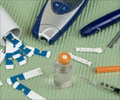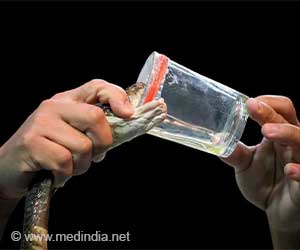A non-invasive, adhesive patch was developed to assess the blood sugar levels accurately in diabetic patients. It was found to be less painful and more accessible than a finger-prick blood test.
- A non-invasive, adhesive patch was developed as an easy way to monitor blood sugar
- The adhesive patch consisting of sensors and reservoirs does not need any calibration with a blood sample and is found to be much easier than a finger-prick blood test
- Millions of diabetics can now avoid the painful and unpopular finger-prick blood test
Instead of piercing the skin, the patch draws glucose out from fluid between cells across hair follicles with the help of miniature sensors using a small electric current. The glucose collected in minute reservoirs is then measured. Readings can be taken once in every 10 to 15 minutes spread over several hours.
TOP INSIGHT
A non-invasive, adhesive patch consisting of tiny sensors and reservoirs has been discovered by scientists as an easy way to monitor blood sugar instead of the usual finger-prick blood test for diabetes.
Concept Behind the Device
The adhesive patch can be available on a low-cost, comfortable to wear sensor, providing an accurate measurement of blood glucose wirelessly to the wearer's phone or smartwatch. It also signals with notifications when they may need to take any action, the study was published in Nature Nanotechnology, the research team from the University of Bath.
Key Advantage of the New Device
Each minute sensor can work in a small area over an individual hair follicle. It increases the accuracy of the measurements by reducing the inter- and intra-skin variability in glucose extraction.
The project is a multidisciplinary collaboration between researchers from the Departments of Physics, Pharmacy & Pharmacology, and Chemistry at the University of Bath.
"The specific architecture of our array permits calibration-free operation, and it has the further benefit of allowing realization with a variety of materials in combination. We utilized graphene as one of the components as it brings important advantages: specifically, it is strong, conductive, flexible, and potentially low-cost and environmentally friendly. In addition, our design can be implemented using high-throughput fabrication techniques like screen printing, which we hope will ultimately support a disposable, widely affordable device." said Dr. Adelina Ilie, from the Department of Physics.
Details of the Study
The research team tested the patch on both pig skin and healthy human volunteers. It provided good results in both and can be used to accurately measure blood glucose levels across the range seen in diabetic human patients throughout the day.
Further modifications of the patch are to increase the number of sensors in the array, to check the functionality over a 24-hour wear period and to undertake some key clinical trials.
About Diabetes
Diabetes mellitus is a metabolic, hormonal disorder caused when the pancreas does not produce sufficient amount of the hormone called insulin. The two major forms of diabetes are type 1 and type 2 diabetes. If type 2 diabetes or diabetes mellitus is not properly managed it can damage body organs such as the eyes, kidneys and the heart.
Diabetes is an ever-increasing serious public health problem. The World Health Organization (WHO) estimates the incidence of diabetes, which may rise from 171 million in 2000 to 366 million in 2030, worldwide. In the UK, only less than six percent of adults have diabetes and the NHS spends around 10% of its budget on diabetes monitoring and treatments. Up to 50% of adults with diabetes are yet to be diagnosed.
People with diabetes or those at high risk of developing diabetes can be benefited with this non-invasive way of monitoring blood glucose using the adhesive patch and make efforts to control or prevent the risk of diabetes.
Reference:
- Luca Lipani, Bertrand G. R. Dupont, Floriant Doungmene, Frank Marken, Rex M. Tyrrell, Richard H. Guy & Adelina Ilie. Non-invasive, transdermal, path-selective and specific glucose monitoring via a graphene-based platform, Nature Nanotechnology (2018)DOI: 10.1038/s41565-018-0112-4
Source-Medindia
 MEDINDIA
MEDINDIA





 Email
Email










